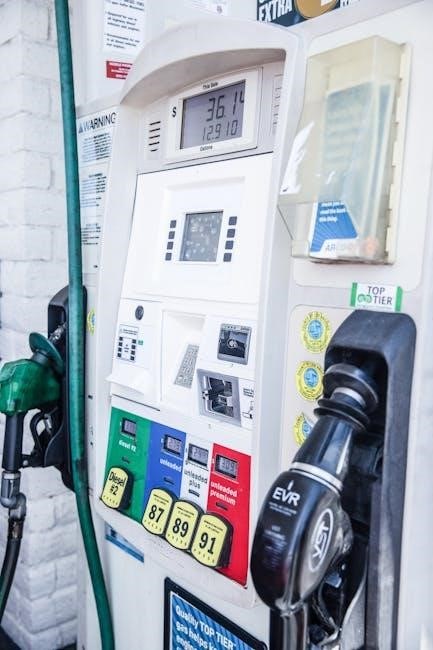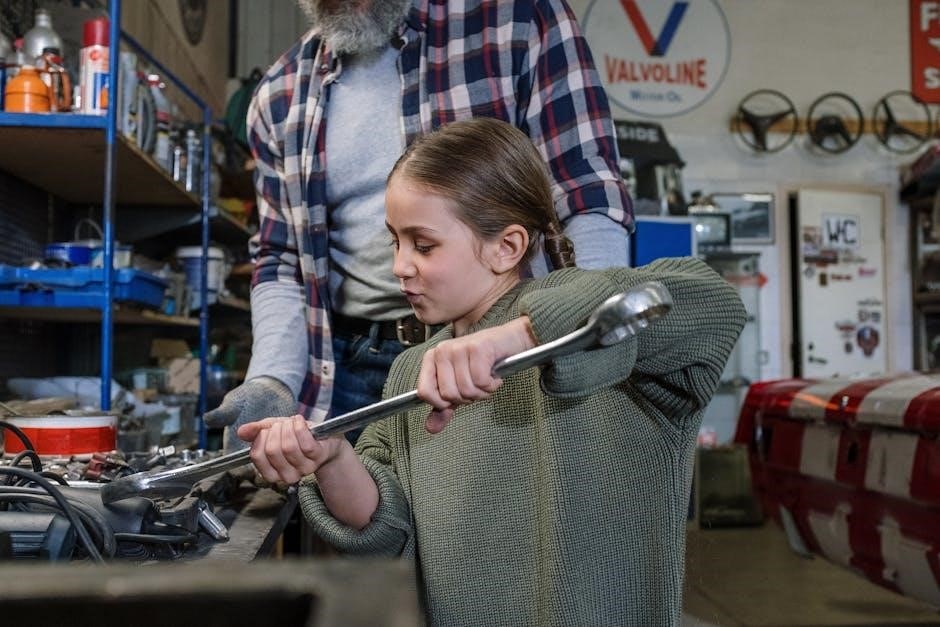instructions for braun thermoscan
1.1 Overview of Braun Thermoscan
The Braun Thermoscan is a clinically proven ear thermometer designed for safe and accurate temperature measurement in newborns, children, and adults.
1.2 Importance of Following Instructions
Following the manual ensures correct usage, accurate readings, and safety. Proper techniques and maintenance are essential for reliable performance and hygiene.
1.3 Safety and Accuracy Guidelines
Use disposable hygiene caps, position the probe correctly, and maintain the device as instructed to ensure precise readings and user safety.
The Braun Thermoscan is a digital ear thermometer designed for quick and accurate temperature measurement. It features a flexible tip for comfort and hygiene caps for safe use across multiple individuals. The device is suitable for newborns, children, and adults, providing precise readings in seconds. Its ergonomic design ensures easy handling, while the clear display offers instant results. Braun Thermoscan is clinically proven for reliability and safety, making it a trusted choice for home and professional use. Regular maintenance and proper usage, as outlined in the manual, ensure optimal performance and longevity.
Following the Braun Thermoscan instructions ensures accurate temperature readings and safe operation. Proper techniques, such as correct probe positioning and using hygiene caps, prevent cross-contamination and maintain precision. Deviating from guidelines can lead to inaccurate results or damage the device. Regular cleaning and maintenance, as outlined, extend the thermometer’s lifespan and reliability. Adhering to safety precautions, like avoiding excessive force during use, protects both the user and the device. By following the manual, users can trust the thermometer for consistent and reliable performance in monitoring health effectively. This ensures optimal functionality and peace of mind for all family members.
The Braun Thermoscan is designed for safe and accurate temperature measurement when used correctly. Always use disposable hygiene caps to prevent cross-contamination and ensure precise readings. Avoid inserting the probe too deeply to prevent eardrum damage. Regularly clean the probe with a soft cloth and avoid harsh chemicals. Store the thermometer in its protective case to prevent damage. Follow the manual’s guidelines for proper positioning and usage to maintain accuracy. Understanding error messages and addressing them promptly ensures reliable performance. Proper care and adherence to safety guidelines extend the device’s lifespan and ensure accurate results for all users.

Components of the Braun Thermoscan
The Braun Thermoscan includes a probe for temperature measurement, a clear digital display, functional buttons for operation, and hygiene caps for safe, accurate, and hygienic use.
2.1 Key Parts and Accessories
The Braun Thermoscan includes essential components like the ergonomic probe with a flexible tip for comfort, a clear digital display for easy reading, and functional buttons for operation. Accessories such as hygiene caps ensure cleanliness and accuracy with each use. The device may also come with a protective case for storage and a base station for convenient charging. These parts work together to provide accurate temperature measurements while maintaining hygiene and user comfort. Proper use of these components is crucial for optimal performance and longevity of the thermometer. Always ensure all parts are clean and properly maintained.
2.2 Understanding the Probe and Display
The Braun Thermoscan features a soft, flexible probe designed for comfort and safety, ensuring it doesn’t insert too deeply into the ear canal. The digital display provides clear, precise temperature readings, with indicators for fever detection and low battery. The probe’s shape protects the eardrum, while the display’s brightness aids visibility. Regular cleaning of the probe with a soft cloth maintains accuracy. The lens filter indicator alerts when a new hygiene cap is needed, ensuring hygienic measurements. Together, the probe and display work seamlessly to deliver quick, reliable results, making it essential to handle them with care to preserve functionality and longevity.
2.3 Buttons and Their Functions
The Braun Thermoscan features a user-friendly interface with buttons designed for easy operation. The Power button turns the device on and off, while the Start button initiates temperature measurement. Some models include a Memo button to recall previously stored readings. Additional buttons may allow navigation through settings or adjustment of features like fever indicators. Pressing and holding the Start button for 5 seconds typically turns off the device. Understanding the button functions ensures efficient and accurate use of the thermometer. Proper button operation is crucial for obtaining reliable readings and maintaining the device’s functionality.
2.4 Hygiene Caps and Their Role
Hygiene caps are essential for maintaining cleanliness and preventing cross-contamination when using the Braun Thermoscan. They create a protective barrier over the probe tip, ensuring hygienic conditions for each measurement. The caps are disposable and should be replaced after every use to maintain accuracy and prevent the spread of germs. Properly fitted caps are designed to fit snugly, ensuring comfort and reliability. Always use genuine Braun hygiene caps for optimal performance. Regularly replacing these caps is a critical step in maintaining the thermometer’s accuracy and extending its lifespan. This ensures safe and reliable temperature measurements for all users.

Preparing for Use
Ensure the Braun Thermoscan is properly powered, clean, and equipped with a hygiene cap before each use for accurate and hygienic temperature measurements.
3.1 Initial Checks Before Measurement
Before using the Braun Thermoscan, ensure the device is clean and free from damage. Verify the hygiene cap is securely attached and not damaged. Check the battery level to avoid low power during use. Ensure the thermometer is turned off and stored properly in its protective case when not in use. Regularly clean the probe with a soft cloth to maintain accuracy and hygiene. Always refer to the user manual for specific guidelines on preparing the device for measurement to ensure reliable results and optimal performance.
3.2 Ensuring Proper Power and Functionality
To ensure proper functionality, turn on the Braun Thermoscan by pressing the start button. The device will automatically turn off after 60 seconds of inactivity to conserve battery life. For manual shutdown, press and hold the start button for 5 seconds. Always use a clean disposable lens filter for each measurement to maintain hygiene and accuracy. Ensure the battery level is sufficient before use, as low power may affect performance. Regularly clean the probe with a soft cloth to prevent dirt buildup, which could interfere with readings. Proper power management and maintenance ensure reliable and precise temperature measurements.
3.3 Importance of Hygiene Caps
Hygiene caps are essential for maintaining cleanliness and preventing cross-contamination. Always use a new cap for each measurement to ensure accuracy and hygiene. Replace the cap immediately after use and dispose of it properly. The caps protect the probe from dirt and bacteria, ensuring precise readings. Regular use of hygiene caps also prevents the spread of infections, making them a critical component for safe and accurate temperature measurement. Always store unused caps in a clean, dry place to maintain their effectiveness. Proper use of hygiene caps is vital for the longevity and reliability of the Braun Thermoscan thermometer.
3.4 Cleaning the Probe
Regularly clean the probe to ensure accuracy and hygiene. Use a soft, dry cloth to wipe the probe gently, avoiding harsh chemicals. Do not submerge the probe in water or use abrasive materials, as this may damage the sensor. Cleaning the probe helps maintain precise temperature readings and prevents contamination. Always check for visible debris and clean the probe before and after use, especially when using it for different individuals. Proper cleaning ensures the longevity of the thermometer and reliable performance. Follow the manual for detailed cleaning instructions to maintain the device’s effectiveness and safety.

Measurement Process
Position the probe gently in the ear canal, ensuring correct alignment for accurate readings. Take the temperature reading and interpret the results based on the displayed data.
4.1 Correct Positioning Techniques
For accurate readings, gently insert the probe into the ear canal, ensuring it aligns with the ear’s natural curve. For adults and children over one year, pull the ear back slightly; for newborns, pull the ear down. Avoid forcing the probe deep, as this could damage the eardrum. Use a new hygiene cap for each measurement to maintain cleanliness. Position the thermometer so the probe tip is lightly touching the eardrum area. Proper alignment ensures precise temperature detection and prevents discomfort. Follow the manual’s visual guide for optimal placement.
4.2 Taking the Temperature Reading
Press the power button to turn on the thermometer. A soft beep will signal it’s ready. Gently insert the probe into the ear canal, following proper positioning guidelines. Hold the device steady; any movement may affect accuracy. Once the probe is correctly placed, the thermometer will emit a soft beep to indicate measurement is complete. The temperature reading will appear on the display. If a fever indicator lights up, it signals a high temperature. Ensure the device is held firmly to avoid errors. The process is quick, typically taking a few seconds, providing a reliable reading for accurate health monitoring.
4.3 Interpreting the Results
Once the measurement is complete, the display shows the temperature reading. The Braun Thermoscan features a fever indicator, which lights up if the temperature is elevated. Green indicates normal, while red signals a fever. The device stores the last reading for quick reference. Compare the result to the individual’s baseline to assess their condition. If the temperature is high, especially in newborns or vulnerable individuals, consult a healthcare professional. Ensure accurate interpretation by following the manual’s guidelines for normal ranges and fever thresholds to make informed decisions about care or further medical advice.
4.4 Understanding Fever Indicators
The Braun Thermoscan features a fever indicator to help quickly assess temperature readings. A green light indicates a normal temperature, while a red light signals a fever. The device may also beep to alert you of elevated readings. Fever thresholds are pre-set based on age groups, ensuring accurate assessments. For newborns and young children, even a slight elevation may require medical attention. Always refer to the manual for specific guidelines on fever ranges and consult a healthcare professional if the temperature exceeds normal levels, especially for vulnerable individuals like infants or the elderly.

Post-Measurement Handling
Turn off the Braun Thermoscan, clean the probe with a soft cloth, and store it in the protective case. Replace hygiene caps after each use to maintain accuracy and hygiene.
5.1 Properly Turning Off the Device
To properly turn off the Braun Thermoscan, press and hold the power button for approximately 5 seconds until the display turns off. This ensures the device powers down completely, helping to conserve battery life and maintain functionality. If not used, the device may also automatically shut off after 60 seconds of inactivity. Always confirm the device is off before storing it to prevent accidental activation and prolong battery performance. Following these steps ensures optimal device maintenance and readiness for future use.
5.2 Storing the Thermometer
After use, store the Braun Thermoscan in its protective case to prevent damage. Ensure the device is clean and dry before storage. Keep it in a cool, dry place, away from direct sunlight and extreme temperatures. Avoid storing it near children to prevent accidental damage or tampering. Regularly check the battery level before storing for extended periods. Proper storage maintains the device’s accuracy and longevity. Always refer to the user manual for additional storage recommendations to ensure optimal performance and durability of your Braun Thermoscan thermometer.
5.3 Cleaning and Maintenance Tips
Regularly clean the Braun Thermoscan with a soft, dry cloth to remove dirt or residues. Gently wipe the probe, avoiding harsh chemicals or submerging it in water. Replace hygiene caps after each use to maintain accuracy and hygiene. Store the thermometer in its protective case when not in use. Ensure the device is dry before storage to prevent moisture damage. Cleaning regularly ensures reliable readings and extends the product’s lifespan. Always refer to the user manual for detailed maintenance instructions to keep your Braun Thermoscan functioning optimally.
5.4 Replacing Hygiene Caps
Replace the hygiene cap after each use to ensure accuracy and maintain hygiene. Remove the used cap by gently pulling it away from the thermometer. Take a new cap from the dispenser, align it with the probe, and press until it clicks into place. Never reuse a hygiene cap, as this can compromise accuracy and hygiene. Dispose of used caps according to local regulations. Regularly check the cap dispenser and refill it as needed. Proper replacement ensures reliable performance and prevents cross-contamination, keeping the thermometer ready for safe and accurate use.

Troubleshooting Common Issues
Address inaccurate readings by ensuring correct positioning and hygiene cap use. Resolve malfunctions by resetting or replacing batteries. Understand error messages for guidance, and reset the device if necessary.
6.1 Addressing Inaccurate Readings
Inaccurate readings may occur due to improper positioning, dirty lenses, or worn hygiene caps. Ensure the probe is correctly placed in the ear canal. Clean the lens with a soft cloth and replace hygiene caps after each use. Check for low battery levels, as this can affect accuracy. If issues persist, reset the thermometer by holding the power button for 5 seconds. Refer to the manual for detailed troubleshooting steps to ensure reliable results. Always follow the manufacturer’s guidelines for optimal performance and accuracy.
6.2 Resolving Device Malfunctions
If your Braun Thermoscan malfunctions, start by checking the battery level and ensuring it is properly powered. Clean the lens and probe with a soft cloth to remove any obstructions. If the device does not turn on, press and hold the power button for 5 seconds to reset it. Ensure all parts are securely connected and hygiene caps are correctly fitted. If issues persist, refer to the user manual for troubleshooting guides or contact Braun customer support for assistance. Regular maintenance and proper handling can prevent most device malfunctions and ensure reliable performance.
6.3 Understanding Error Messages
The Braun Thermoscan displays error messages like “Err1” or “Err2” to indicate specific issues. “Err1” typically signifies a faulty or dirty lens filter, while “Err2” may point to low battery or improper device handling. If you see “LO”, it indicates a low battery level requiring replacement. Always clean the lens and probe gently with a soft cloth and ensure the hygiene cap is securely fitted. If errors persist, reset the device by turning it off and on or refer to the manual for detailed troubleshooting. Understanding these messages helps maintain accuracy and ensures proper functioning of the thermometer.
6;4 Resetting the Thermometer
To reset the Braun Thermoscan, turn it off and wait for 10 seconds. Press and hold the power button until it turns on again. This restores factory settings without erasing stored data. Resetting is useful if the device malfunctions or if you want to revert to default settings. After resetting, recalibrate if necessary and ensure the lens filter is clean and properly attached. Resetting does not delete stored temperature records, allowing you to maintain historical data while resolving any software-related issues. Always refer to the manual for specific reset procedures for your model.

Battery Management
Use high-quality batteries to ensure optimal performance. Store batteries in a cool, dry place to maintain their lifespan. Avoid over-discharging to prevent device malfunction. Always turn off the thermometer before replacing batteries to ensure accurate readings afterward. Proper battery care extends the life of your Braun Thermoscan and ensures reliable temperature measurements.
7.1 Checking Battery Levels
To ensure your Braun Thermoscan operates reliably, regularly check the battery level. The device features a low-battery indicator, which lights up when power is low. If the indicator appears, replace the batteries promptly. To check battery levels, observe the device’s performance: a dimming LCD or slower operation may signal weak batteries. Always use high-quality, compatible batteries to maintain accuracy and functionality. Avoid mixing old and new batteries to prevent power fluctuations. Proper battery care ensures consistent and accurate temperature measurements. Refer to the user manual for detailed instructions on battery replacement and maintenance.
7.2 Replacing Batteries
To replace the batteries in your Braun Thermoscan, first ensure the device is turned off. Locate the battery compartment, usually found at the back or bottom of the thermometer. Open it by sliding the cover or using a screwdriver, depending on the model. Remove the old batteries and insert new ones, ensuring they are placed correctly with the positive and negative terminals aligned. Use high-quality, compatible batteries to maintain performance. Close the compartment securely and turn the device on to test its functionality. Proper battery replacement ensures accurate readings and extends the lifespan of your thermometer.

7.3 Handling the Battery for Base Station
The Braun Thermoscan base station uses a rechargeable NiMH battery pack, ensuring long-term reliability. To maintain optimal performance, use only the provided low-voltage adapter for charging. Avoid overcharging, as this can reduce battery lifespan. When charging, the LED indicator will show a red light, turning green once fully charged. Store the battery in a cool, dry place at room temperature. If the battery is completely drained, allow it to charge for at least 12 hours before use. Replace the battery pack only with an authorized Braun replacement to ensure safety and compatibility.

Advanced Features and Customization
The Braun Thermoscan features advanced customization options and seamless syncing with the Braun Family Care app for enhanced temperature tracking and personalized settings management.
8.1 Syncing with Braun Family Care App
The Braun Thermoscan 7 and PRO 6000 models are compatible with the Braun Family Care app, enabling users to track temperature readings, monitor trends, and receive personalized insights; To sync, scan the QR code in the manual and download the app. Follow in-app instructions to pair the thermometer with your smart device. This feature allows for seamless data transfer, historical tracking, and convenient monitoring of family members’ health. The app also provides guidance for interpreting readings and offers customizable settings for enhanced usability.
8.2 Using Advanced Features
The Braun Thermoscan 7 and PRO 6000 models offer advanced features like fever indicators, silent mode, and customizable settings. The thermometer includes a memory recall function to store previous readings, allowing users to track temperature trends over time. Additionally, age-adjusted settings ensure accurate fever detection for different age groups. Silent mode minimizes noise during measurements, ideal for use with infants or during the night. These advanced features enhance user convenience, improve accuracy, and provide personalized health monitoring options for families.
8.3 Customizing Device Settings
The Braun Thermoscan allows users to customize settings for personalized use. Through the Braun Family Care app, users can sync their thermometer to track temperature readings and receive notifications. Silent mode can be activated for discreet measurements, especially for infants. Age-adjusted settings enable accurate fever detection tailored to different age groups. Users can also adjust brightness and units of measurement (°C/°F) for convenience. These customization options enhance usability and ensure the device meets individual preferences, providing a seamless and intuitive experience for all family members.

Safety Precautions
Ensure safe handling and use of the Braun Thermoscan. Avoid inserting the probe too deeply to prevent eardrum damage. Suitable for all age groups, from newborns to adults. Always use disposable hygiene caps to maintain cleanliness and prevent cross-contamination. Store the device in its protective case to avoid damage. Regularly clean the probe with a soft cloth and avoid harsh chemicals. Follow all instructions carefully to ensure accurate readings and user safety.
9.1 Suitable Users and Age Groups
The Braun Thermoscan is designed for use with individuals of all ages, from newborns to geriatric adults. It is ideal for home use and clinical settings, ensuring accurate and safe temperature measurement. The thermometer is particularly suitable for newborns due to its gentle, flexible tip, which minimizes discomfort. For children, adult supervision is recommended to ensure proper use and safety. The device is intended for intermittent measurement and is compatible with a wide range of users, making it a versatile choice for families and healthcare professionals. Always follow the instructions for appropriate use in different age groups.
9.2 Avoiding Potential Damages
To prevent damage to your Braun Thermoscan, handle it with care. Avoid dropping the device or exposing it to harsh chemicals. Clean the probe gently with a soft cloth and avoid submerging it in water. Store the thermometer in its protective case when not in use to prevent scratches or impacts. Do not expose the device to extreme temperatures, as this may affect its accuracy. Avoid using the thermometer near moisture or in humid environments. Proper storage and handling will ensure the longevity and reliability of your Braun Thermoscan thermometer.
9.3 Safe Handling Practices
Always handle the Braun Thermoscan with care to ensure safety and accuracy. Use the thermometer only as directed in the manual. Avoid touching the probe tip to prevent contamination and ensure accurate readings. Use disposable hygiene caps for each measurement to maintain hygiene. Store the device in its protective case to prevent damage. Avoid exposing the thermometer to extreme temperatures or harsh chemicals. Handle the device gently to prevent damage to the probe or display. Regular cleaning with a soft cloth is recommended. Follow these practices to ensure safe and effective use of your Braun Thermoscan thermometer.
By following this guide, you ensure accurate readings and safe handling of your Braun Thermoscan. Clinically proven for precision, it’s designed for reliable long-term use with proper care.
10.1 Recap of Key Instructions
Always use hygiene caps for accuracy and hygiene. Ensure proper probe positioning and power functionality before measurement. Interpret readings with fever indicators for quick reference. Clean the probe regularly and store the thermometer in its case. Replace batteries as needed and avoid harsh chemicals. Follow the manual for troubleshooting and maintenance. Regularly check for updates and sync with the Braun Family Care app for advanced features. Proper handling ensures long-term reliability and safe usage for all age groups, from newborns to adults.
10.2 Final Tips for Optimal Use
Regularly clean the probe with a soft cloth and avoid harsh chemicals. Store the thermometer in its protective case to prevent damage. Always use fresh hygiene caps for each measurement to maintain accuracy and hygiene. Sync with the Braun Family Care app for advanced features and tracking. Practice proper positioning techniques for consistent results. Refer to the manual for troubleshooting and maintenance. Ensure batteries are checked and replaced as needed. By following these tips, you can ensure reliable performance, safety, and longevity of your Braun Thermoscan thermometer for accurate temperature monitoring across all age groups;






























